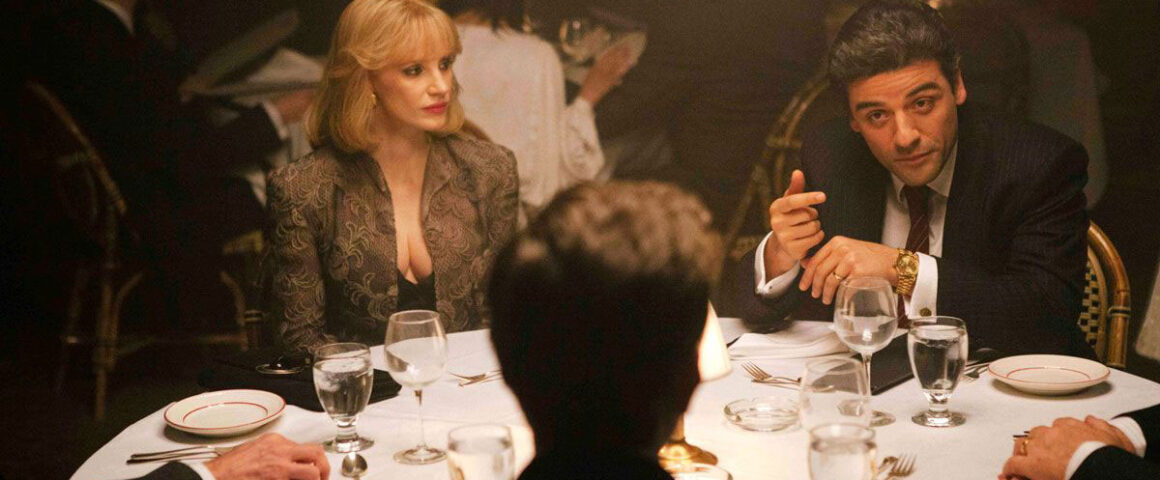J. C. Chandor’s New York drama, A Most Violent Year, is a misleadingly titled film, as its timeframe only covers a month and there is very little physical violence. While the title references the exceptionally high crime rate of New York in 1981, the film itself is an intriguing study of different types of violence, their effects, and their escalation, rather than the gangster-esque tale that the title, poster (in which Oscar Isaac looks like Michael Corleone) and trailer suggest.
Oil traders Abel (Oscar Isaac, “Inside Llewyn Davis”) and Anna (Jessica Chastain, “Interstellar”) Morales are expanding their business, with thirty days to complete purchase of an oil depot which will further strengthen the business. The expansion is threatened, however, by the violent theft of oil from their tankers, one of these heists taking place at the start of the film and leaving a driver badly injured. Abel suspects his competitors are behind the thefts but refuses to resort to violence, despite the exhortations of Anna as well as their lawyer Andrew Walsh (Albert Brooks, “Drive”) for drivers to be armed. Meanwhile, Abel must also deal with the District Attorney’s Office, as DA Lawrence (David Oyelowo, “Selma”) launches a criminal investigation into the company, despite Abel having already provided all records to the DA’s office.
On paper, this sounds like a rather dry tale of finance and accounting. The reality is more surprising, as A Most Violent Year is a slowburn character drama, with a detailed sociological backdrop and a probing exploration of ambition, honor and capitalism. The film de-romanticizes the American Dream, showing that financial success in the “land of opportunity” comes with a heavy price. The film is far from a flag-weaving endorsement of American capitalism, however, because the emphasis is not upon money but on integrity and responsibility, providing for one’s family and, by extension, one’s employees and their families. This benevolent view of the capitalist entrepreneur may ruffle feathers among the more left-leaning viewer, but to understand A Most Violent Year is to accept this view and then examine how the film unpacks the sometimes naïve ideology of Abel.
The film’s great strength is its willingness to perform this unpacking slowly, Chandor utilizing a deliberate pace which allows imperatives to be explained to the audience as well as other characters. This measured approach builds atmosphere and helps the viewer appreciate what is at stake, and experience Abel’s fear and frustration as the financial, legal and physical violence escalates. Abel’s commitment to avoid violence clashes with Anna, whose gangster background makes her more willing to use extra-legal responses. Their different racial backgrounds add an interesting dimension to the film’s unromanticized American Dream — Abel, the Latino immigrant who has succeeded by embracing the virtues of hard work, patience and determination; Anna, the white American-born who accepts a need for short cuts, dishonesty and even violence. In their respective roles, Isaac and Chastain shine as a couple who disagree, sometimes furiously, but still have a strong and resilient relationship, both partners committed to the health and security of their family and, by extension, their business, even if they differ in the means that they are prepared to use.
This tension between legal and not-so-legal methods constitutes the film’s main conflict, and illustrates the film’s non-romantic view of capitalist success. Director of photography Bradford Young gives the film a beautiful, nostalgic glow: Many interior scenes are lit with a golden hue, while external scenes feature a stark contrast between people and their snow-covered surroundings. There is an irony in this cinematography — it suggests golden nostalgia while presenting events as anything but golden, or perhaps showing the true cost of the gold-paved streets of America (or should that be the oil-rich streets?). Despite his best efforts, Abel cannot completely avoid making uncomfortable decisions, and the film’s deliberate pace ensures that the viewer appreciates the difficulty of his choices. This is especially apparent in the film’s standout set piece: A chase that begins with vehicles, then progresses on foot before moving onto a train and culminates with the film’s most brutal moment of violence. This sequence echoes the famous chase in “The French Connection,” but again is not shot frenetically but deliberately, which serves to draw out the tension as we remain with Abel throughout. Much of the early part of the sequence is shot from within Abel’s car, our view restricted to what he can see. The camera later remains with the protagonist as he runs after his quarry, the viewer feeling Abel’s anger and determination as we move at his pace. The sequence is ultimately problematic, as it seems to endorse physical violence and even torture, whereas the rest of the film suggests that any use of violence is tragic. The erosion of Abel’s ethical conviction and acceptance of Anna’s recommendations are presented as weary resignation rather than willing damnation, making the film and ambiguous about the morality of what takes place. The film suggests that any commercial endeavor will involve compromise, and that both illegal and even violent activity is endemic to American capitalism.
Abel’s ethical compromise juxtaposes a significant success with a moment of sickening violence. This echoes a sentiment in the far more ferocious “Gangs of New York:” The idea of America being born in blood. A Most Violent Year is more reserved and concerns competition between legitimate businesses rather than criminal gangs (while blurring the lines between them), but it depicts a similar conceit that violence is intrinsic to American society and American capitalism. It is perhaps significant that the commodity being traded is oil, an ongoing cause of conflict in American foreign trade and policy. A Most Violent Year therefore also echoes “There Will Be Blood” in its domestication of America’s oil conflict, demonstrating that success is possible and everyone can work together, but only some people win while others lose everything.





'Movie Review: A Most Violent Year (2014)' have 5 comments
January 22, 2015 @ 2:03 pm kickthecan
Jessica Chastain deserves mention for an Oscar for he work here for sure. Sadly for her though, she is the female Leonardo DiCaprio: the best actor that will never win the Academy Award.
January 22, 2015 @ 2:46 pm Apple
The American Hustle for 2014? The look of Chastain’s cleavage reminds me of Adams’ ..
January 22, 2015 @ 3:29 pm MrNorml
I didn’t have this on my list of watches but now I’ll be on the look out for it
January 22, 2015 @ 6:52 pm Dave Elders
Ain’t nothing pretty about the underworkings of business. Everything built is built upon blood, sweat, tears and dirt.
January 22, 2015 @ 11:43 pm old navy
Margin Call, All is Lost, A Most Violent Year. All great movies. J.C. Chandor is a director I’m high on.